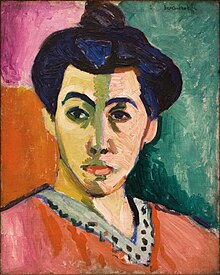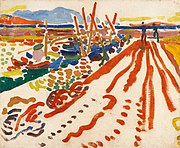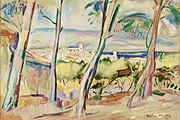Fauvism

Fauvism is the style of les Fauves (French for "the wild beasts"), a loose group of early twentieth-century Modern artists whose works emphasized painterly qualities and strong color over the representational or realistic values retained by Impressionism. While Fauvism as a style began around 1900 and continued beyond 1910, the movement as such lasted only a few years, 1904–1908, and had three exhibitions.[1][2] The leaders of the movement were Henri Matisse and André Derain.[1]
Artists and style
Besides Matisse and Derain, other artists included Albert Marquet, Charles Camoin, Louis Valtat, the Belgian painter Henri Evenepoel, Maurice Marinot, Karl Pärsimägi, Jean Puy, Maurice de Vlaminck, Henri Manguin, Raoul Dufy, Othon Friesz, Georges Rouault, Jean Metzinger, the Dutch painter Kees van Dongen and Georges Braque (subsequently Picasso's partner in Cubism).[1]
The paintings of the Fauves were characterized by seemingly wild brush work and strident colors, while their subject matter had a high degree of simplification and abstraction.[3] Fauvism can be classified as an extreme development of Van Gogh's Post-Impressionism fused with the pointillism of Seurat[3] and other Neo-Impressionist painters, in particular Paul Signac. Other key influences were Paul Cézanne[4] and Paul Gauguin, whose employment of areas of saturated color—notably in paintings from Tahiti—strongly influenced Derain's work at Collioure in 1905.[5] In 1888 Gauguin had said to Paul Sérusier:[6]
How do you see these trees? They are yellow. So, put in yellow; this shadow, rather blue, paint it with pure ultramarine; these red leaves? Put in vermilion.
Fauvism can also be seen as a mode of Expressionism.[3]
Origins

Gustave Moreau was the movement's inspirational teacher;[7] a controversial professor at the École des Beaux-Arts in Paris and a Symbolist painter, he taught Matisse, Marquet, Manguin, Rouault and Camoin during the 1890s, and was viewed by critics as the group's philosophical leader until Matisse was recognized as such in 1904.[7] Moreau's broad-mindedness, originality and affirmation of the expressive potency of pure color was inspirational for his students.[8] Matisse said of him, "He did not set us on the right roads, but off the roads. He disturbed our complacency."[8] This source of empathy was taken away with Moreau's death in 1898, but the artists discovered other catalysts for their development.[8]
In 1896, Matisse, then an unknown art student, visited the artist John Peter Russell on the island of Belle Île off Brittany.[9] Russell was an Impressionist painter; Matisse had never previously seen an Impressionist work directly, and was so shocked at the style that he left after ten days, saying, "I couldn't stand it any more."[9] The next year he returned as Russell's student and abandoned his earth-colored palette for bright Impressionist colors, later stating, "Russell was my teacher, and Russell explained color theory to me."[9] Russell had been a close friend of Vincent van Gogh and gave Matisse a Van Gogh drawing.[9]

In 1901, Maurice de Vlaminck encountered the work of Van Gogh for the first time at an exhibition, declaring soon after that he loved Van Gogh more than his own father; he started to work by squeezing paint directly onto the canvas from the tube.[8] In parallel with the artists' discovery of contemporary avant-garde art came an appreciation of pre-Renaissance French art, which was shown in a 1904 exhibition, French Primitives.[8] Another aesthetic influence was African sculpture, of which Vlaminck, Derain and Matisse were early collectors.[8]
Many of the Fauve characteristics first cohered in Matisse's painting, Luxe, Calme et Volupté ("Luxury, Calm and Pleasure"), which he painted in the summer of 1904, whilst in Saint-Tropez with Paul Signac and Henri-Edmond Cross.[8]
Salon d'Automne 1905

After viewing the boldly colored canvases of Henri Matisse, André Derain, Albert Marquet, Maurice de Vlaminck, Kees van Dongen, Charles Camoin, and Jean Puy at the Salon d'Automne of 1905, the critic Louis Vauxcelles disparaged the painters as "fauves" (wild beasts), thus giving their movement the name by which it became known, Fauvism. The artists shared their first exhibition at the 1905 Salon d'Automne. The group gained their name after Vauxcelles described their show of work with the phrase "Donatello chez les fauves" ("Donatello among the wild beasts"), contrasting their "orgie of tones" with a Renaissance-style sculpture that shared the room with them.[11][12] Henri Rousseau was not a Fauve, but his large jungle scene The Hungry Lion Throws Itself on the Antelope was exhibited near Matisse's work and may have had an influence on the pejorative used.[13] Vauxcelles' comment was printed on 17 October 1905 in Gil Blas,[11] a daily newspaper, and passed into popular usage.[12][14] The pictures gained considerable condemnation—"A pot of paint has been flung in the face of the public", wrote the critic Camille Mauclair (1872–1945)—but also some favorable attention.[12] The painting that was singled out for attacks was Matisse's Woman with a Hat; this work's purchase by Gertrude and Leo Stein had a very positive effect on Matisse, who was suffering demoralization from the bad reception of his work.[12] Matisse's Neo-Impressionist landscape, Luxe, Calme et Volupté, had already been exhibited at the Salon des Indépendants in the spring of 1905.[15]

Gallery
-
André Derain, 1905, Le séchage des voiles (The Drying Sails), 1905, Pushkin Museum, Moscow
-
Maurice de Vlaminck, 1905–06, Barges on the Seine (Bateaux sur la Seine), oil on canvas, 81 x 100 cm, Pushkin Museum, Moscow
-
André Derain, 1906, Charing Cross Bridge, London, National Gallery of Art, Washington, DC.
-
André Derain, La jetée à L'Estaque, 1906, oil on canvas, 38 x 46 cm
-
Maurice de Vlaminck, The River Seine at Chatou, 1906, Metropolitan Museum of Art
-
Kees van Dongen, Woman with Large Hat, 1906
-
Henri Manguin, 1906, Baigneuse (Woman Bather), oil on canvas, Pushkin Museum, Moscow
-
Jean Metzinger, 1907, Paysage coloré aux oiseaux aquatique, oil on canvas, 74 x 99 cm, Musée d’Art Moderne de la Ville de Paris
-
Othon Friesz, 1907, Paysage à La Ciotat, oil on canvas, 59.9 x 72.9 cm
See also
Notes and references
- ^ a b c John Elderfield, The "Wild Beasts" Fauvism and Its Affinities, 1976, Museum of Modern Art, p.13, ISBN 0-87070-638-1
- ^ Freeman, Judi, et al., The Fauve Landscape, 1990, Abbeville Press, p. 13, ISBN 1-55859-025-0.
- ^ a b c Tate (2007). Glossary: Fauvism. Retrieved on 2007-12-19, Tate
- ^ Freeman, 1990, p. 15.
- ^ Teitel, Alexandra J. (2005). "History: How did the Fauves come to be?". "Fauvism: Expression, Perception, and the Use of Color", Brown University. Retrieved on 2009-06-18, Brown courses
- ^ Collins, Bradley, Van Gogh and Gauguin: Electric Arguments and Utopian Dreams, 2003, Westview Press, p. 159, ISBN 0-8133-4157-4.
- ^ a b Freeman, p. 243
- ^ a b c d e f g Dempsey, Amy (2002). Styles, Schools and Movements: An Encyclopedic Guide to Modern Art, pp. 66-69, London: Thames & Hudson Ltd.
- ^ a b c d "Book talk: The Unknown Matisse...", ABC Radio National, interview with Hilary Spurling, 8 June 2005. Retrieved 1 January 2008.
- ^ Matisse, Luxe, calme et volupté, 1904, Musée d'Orsay, Paris, France
- ^ a b Louis Vauxcelles, Le Salon d'Automne, Gil Blas, 17 October 1905. Screen 5 and 6. Gallica, Bibliothèque nationale de France, ISSN 1149-9397
- ^ a b c d Chilver, Ian (Ed.). "Fauvism", The Oxford Dictionary of Art, Oxford University Press, 2004. Retrieved from enotes.com, 26 December 2007.
- ^ Smith, Roberta (2006). "Henri Rousseau: In imaginary jungles, a terrible beauty lurks" The New York Times, 14 July 2006. Accessed 29 December 2007
- ^ Elderfield,p.43
- ^ Salon d'automne; Société du Salon d'automne, Catalogue des ouvrages de peinture, sculpture, dessin, gravure, architecture et art décoratif. Exposés au Grand Palais des Champs-Élysées, 1905
- ^ Interpol issues global alert for stolen art, CNN Wire Staff, May 21, 2010
Further reading
- Gerdts, William H. (1997). The Color of Modernism: The American Fauves. New York: Hollis Taggart Galleries. pp. 160 p.
- Spivey, Virginia, Fauvism, Smarthistory at Khan Academy
- Whitfield, Sarah (1991). Fauvism. London: Thames and Hudson. ISBN 0-500-20227-3.
External links
- Fauve Painting from the Permanent Collection at the National Gallery of Art
- Fauvism: The Wild Beasts of Early Twentieth Century Art
- Rewald, Sabine. Fauvism. In Timeline of Art History. New York: The Metropolitan Museum of Art (2004)
- Gelett Burgess, The Wild Men of Paris, Matisse, Picasso and Les Fauves, 1910

















